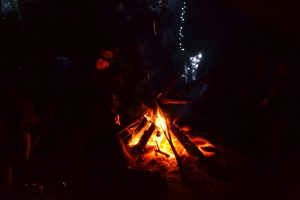Beltane is an ancient festival day which until recently had been largely forgotten it would seem but due to a neo-pagan revival to have been increasingly observed. One of the earliest and certainly most vibrant is that established in 1988 by a musical collective called Test Dept as their website records:
“The event was intended as a celebration of traditional rituals as a local manifestation of an international spirit……Choreography, iconography and performance were moulded by the originators’ research into historical accounts of Beltane and their own influences (e.g. Test Department’s drumming, Trinidadian carnival, and ritual dance and performance).”
In a way of the custom is a sort of revival as Edinburgh had a tradition of beltane celebrations located on Arthur’s seat of which the washing in May Dew is the last remnant. However, anyone who has been to the told of Arthur’s seat would attest it is big on scenery but small on space! Thus the location was moved to Carlton Hill. The first Beltane fire festivals were a success:
“Originally an event with a core of a dozen performers and a few hundred audience, the event has grown to several hundred performers and over ten thousand audience. Key characters within the performance are maintained, though reinterpreted by their performers, and additional participants incorporated each year.”
Popularity has brought its challenges as the website notes:
“Originally, the festival was free and only lightly stewarded, however, as the event has grown in popularity, due to the capacity of the hill, funding requirements… the festival has in recent years moved to being a ticketed event.”
It certainly is a vibrant and busy event. I followed ticket in my hand the throng of people, devotes to the fire festival as they snaked up the hill. Once in you really do feel this is an immersive experience everywhere there is action, sounds, sights, smells and excitement. However, getting that killer photo is more of a challenge!

The event starts with a procession of a resplendent white May Queen with a foliage covered green man with as their website states:
“followed by a cavalcade of characters who are intrinsically linked to them and their journey. Their destination is punctuated by various groups who either help or hinder their progress towards the Green Man’s fate and the May Queen’s destiny.”
If it wasnt them it was the throng of onlookers jostling for a position! The May Queen signifies the beginning of summer physically emphasized by the lighting of an immense bonfire. Once this has happened the performers move around the site integrating with great aplomb and flashes of red, white and toplessness! Writhing bodies and jumping in and out of the crowds creating a magical. Many doing the traditional jumping through the fire for luck and causes woops and cheers from the crowd.

After a dramatic stage performance signifying the inception of summer the May Queen and Green Man spark the birth of summer by lighting a huge bonfire. The performance then moves into its community phase. All the participants congregate in a place called the Bower. From here the finishing movements of the festival are played out in a dance of reds and whites. This is also where the home comforts of warmth, food and drink are provided to the tired and often very cold performers and crew. As the website notes:
“There are very few barriers between the audience and performers which offers up opportunity for an immersive experience. It is one where you are likely to come face-to-face with one of our colourful characters, or can step back and marvel at the scale of a production wrought in only two months by around three hundred volunteers. The presentation may leave you figuratively in the dark regarding what is being portrayed, but there is also a chance you may find yourself literally there too. One suggestion is to ‘head to the high ground and then follow the sound of drumming.”
The sound was indeed incredible and all in all this is an amazing event custom a must to experience and be part of. Less of an event to experience what Beltane was like in the pre-Modern years I would add but that is beside the point Edinburgh should be justly proud of this fantastic addition to the folklore calendar. A must! I left a bit before it finished and looked back at Carlton hill the spectacle of rich reds and oranges pours across the Edinburgh skyline creating an exciting vista.


